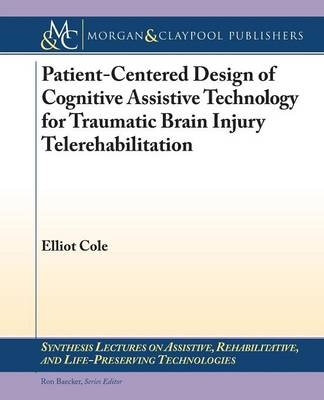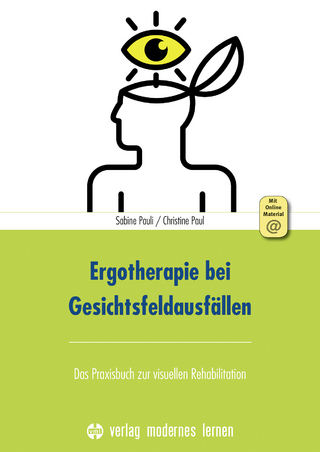
Patient-Centered Design of Cognitive Assistive Technology for Traumatic Brain Injury Telerehabilitation
Seiten
2013
Morgan & Claypool Publishers (Verlag)
978-1-60845-643-7 (ISBN)
Morgan & Claypool Publishers (Verlag)
978-1-60845-643-7 (ISBN)
Describes a quarter century of computing R&D at the Institute for Cognitive Prosthetics, focusing on the needs of individuals with cognitive disabilities from brain injury. Models and methods from Human Computer Interaction (HCI) have been particularly valuable, initially in illuminating those needs.
Computer software has been productive in helping individuals with cognitive disabilities. Personalizing the user interface is an important strategy in designing software for these users, because of the barriers created by conventional user interfaces for the cognitively disabled. Cognitive assistive technology (CAT) has typically been used to provide help with everyday activities, outside of cognitive rehabilitation therapy.
This book describes a quarter century of computing R&D at the Institute for Cognitive Prosthetics, focusing on the needs of individuals with cognitive disabilities from brain injury. Models and methods from Human Computer Interaction (HCI) have been particularly valuable, initially in illuminating those needs. Subsequently HCI methods have expanded CAT to be powerful rehabilitation therapy tools, restoring some damaged cognitive abilities which have resisted conventional therapy.
Patient-Centered Design (PCD) emerged as a design methodology which incorporates both clinical and technical factors. PCD also takes advantage of the patient's ability to redesign and refine the user interface, and to achieve a very good fit between user and system.
Cognitive Prosthetics Telerehabilitation is a powerful therapy modality. Essential characteristics are delivering service to patients in their own home, having the patient's priority activities be the focus of therapy, using cognitive prosthetic software which applies Patient Centered Design, and videoconferencing with a workspace shared between therapist and patient.
Cognitive Prosthetics Telerehabilitation has a rich set of advantages for the many stakeholders involved with brain injury rehabilitation.
Computer software has been productive in helping individuals with cognitive disabilities. Personalizing the user interface is an important strategy in designing software for these users, because of the barriers created by conventional user interfaces for the cognitively disabled. Cognitive assistive technology (CAT) has typically been used to provide help with everyday activities, outside of cognitive rehabilitation therapy.
This book describes a quarter century of computing R&D at the Institute for Cognitive Prosthetics, focusing on the needs of individuals with cognitive disabilities from brain injury. Models and methods from Human Computer Interaction (HCI) have been particularly valuable, initially in illuminating those needs. Subsequently HCI methods have expanded CAT to be powerful rehabilitation therapy tools, restoring some damaged cognitive abilities which have resisted conventional therapy.
Patient-Centered Design (PCD) emerged as a design methodology which incorporates both clinical and technical factors. PCD also takes advantage of the patient's ability to redesign and refine the user interface, and to achieve a very good fit between user and system.
Cognitive Prosthetics Telerehabilitation is a powerful therapy modality. Essential characteristics are delivering service to patients in their own home, having the patient's priority activities be the focus of therapy, using cognitive prosthetic software which applies Patient Centered Design, and videoconferencing with a workspace shared between therapist and patient.
Cognitive Prosthetics Telerehabilitation has a rich set of advantages for the many stakeholders involved with brain injury rehabilitation.
Introduction
Some Clinical Features of the Cognitive Disabilities Domain with TBI Examples
Adapting Computer Software to Address Cognitive Disabilities
The Primacy of the User Interface
Patient-Centered Design
Cognitive Prosthetics Telerehabilitation
The Active User and the Engaged User
Patient Case Studies in the Use of Cognitive Assistive Technology: Successes and Failures
Conclusions, Factors Influencing Outcomes, Anomalies, and Opportunities
Bibliography
| Erscheint lt. Verlag | 30.3.2013 |
|---|---|
| Reihe/Serie | Synthesis Lectures on Assistive, Rehabilitative, and Health-Preserving Technologies |
| Verlagsort | San Rafael |
| Sprache | englisch |
| Maße | 191 x 235 mm |
| Gewicht | 304 g |
| Themenwelt | Medizin / Pharmazie ► Gesundheitswesen |
| Medizin / Pharmazie ► Medizinische Fachgebiete ► Neurologie | |
| Physiotherapie / Ergotherapie ► Rehabilitation ► Neuro-Rehabilitation | |
| ISBN-10 | 1-60845-643-9 / 1608456439 |
| ISBN-13 | 978-1-60845-643-7 / 9781608456437 |
| Zustand | Neuware |
| Haben Sie eine Frage zum Produkt? |
Mehr entdecken
aus dem Bereich
aus dem Bereich
das Praxisbuch zur visuellen Rehabilitation
Buch | Spiralbindung (2023)
modernes lernen (Verlag)
29,95 €
Untersuchen, Üben, Eigentraining
Buch | Hardcover (2022)
Thieme (Verlag)
110,00 €
Alltag mit Hirnverletzung
Buch | Softcover (2023)
Lehmanns Media (Verlag)
24,95 €


